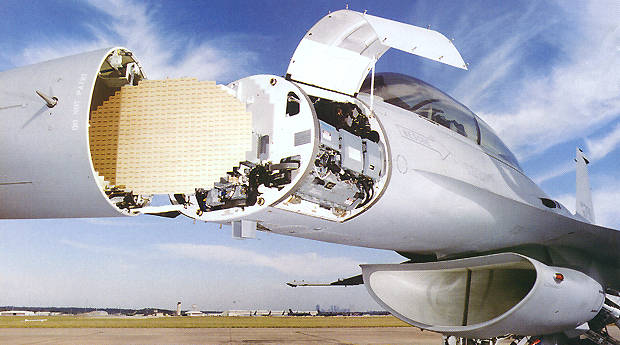Fighter Jet News
F-16 Fighting Falcon News
Raytheon and Northrop Grumman battle over F-16 radars
November 7, 2007 (by
Asif Shamim) -
Northrop Grumman is designing a new active array radar for the Lockheed Martin F-16, as the company seeks to defend its suddenly vulnerable monopoly on the fighter's main sensor equipment.
Northrop currently supplies the mechanically scanned APG-68 radar to US and foreign F-16 customers and the APG-80 active electronically scanned array (AESA) radar for the block 60 aircraft sold to the United Arab Emirates. However, its four-decade-old lock on the market has recently come under attack.
In July, Raytheon disclosed plans to offer a scaled-down version of the APG-79 AESA, with the so-called Raytheon Next Generation Radar aimed at the single-engine fighter market, including the F-16, T/A-50 and Saab Gripen.
The APG-79 is a new development for the U.S. Navy F/A-18E/F Super Hornet aircraft, providing enhanced reliability and a high level of aircrew situational awareness. The AESA radar has an exceptionally agile beam, providing nearly instantaneous track updates and enhanced multi-target tracking capability.
Northrop will not leave Raytheon's advance unchecked, and is designing a lightweight, thin-array system to replace the APG-68's mechanically scanned arrays.
The F-16 retrofit package is being designed to require no "group-A", or structural or wiring, modifications to the aircraft. The upgraded radar will include its own liquid-cooling heat exchanger that fits within the available space, says James Pitts, president of its electronic systems sector.
Lockheed officials have previously confirmed that they expect the US Air Force to eventually upgrade the F-16 radar to the AESA standard, and welcome a budding competition between Northrop and Raytheon. Pitts also foresees the USAF as a potential customer, but views the export market as the most likely source of a launch order.
Actual radar range is classified and depend on the target and altitude. But roughly, the F-16 upgrade will likely come in at 125 mi. or slightly less.
Reliability of the AESA design is a huge selling point for the military. Because there are no moving parts, production radars are expected to last the lifetime, sometimes twice the lifetime, of the aircraft without repairs and perhaps without ever even opening the radar, says Teri Marconi, Northrop Grumman's vice president of combat avionics systems. About 20% of the transmitter/receiver elements can fail without affecting performance noticeably, say other radar specialists.
Future software upgrades, some of which are already in the budget, are to make electronic attack (including jamming, inserting false targets and messages, and tactical network invasion) a staple of combat operations. Moreover, if all the AESA radar's transmitter elements are focused on a single target, the spike of energy produced in it could scramble computer memories and damage delicate electronic components of enemy cruise missiles, helicopters, air defense radars or aircraft.
In July, Raytheon disclosed plans to offer a scaled-down version of the APG-79 AESA, with the so-called Raytheon Next Generation Radar aimed at the single-engine fighter market, including the F-16, T/A-50 and Saab Gripen.
The APG-79 is a new development for the U.S. Navy F/A-18E/F Super Hornet aircraft, providing enhanced reliability and a high level of aircrew situational awareness. The AESA radar has an exceptionally agile beam, providing nearly instantaneous track updates and enhanced multi-target tracking capability.
Northrop will not leave Raytheon's advance unchecked, and is designing a lightweight, thin-array system to replace the APG-68's mechanically scanned arrays.
The F-16 retrofit package is being designed to require no "group-A", or structural or wiring, modifications to the aircraft. The upgraded radar will include its own liquid-cooling heat exchanger that fits within the available space, says James Pitts, president of its electronic systems sector.
Lockheed officials have previously confirmed that they expect the US Air Force to eventually upgrade the F-16 radar to the AESA standard, and welcome a budding competition between Northrop and Raytheon. Pitts also foresees the USAF as a potential customer, but views the export market as the most likely source of a launch order.
Actual radar range is classified and depend on the target and altitude. But roughly, the F-16 upgrade will likely come in at 125 mi. or slightly less.
Reliability of the AESA design is a huge selling point for the military. Because there are no moving parts, production radars are expected to last the lifetime, sometimes twice the lifetime, of the aircraft without repairs and perhaps without ever even opening the radar, says Teri Marconi, Northrop Grumman's vice president of combat avionics systems. About 20% of the transmitter/receiver elements can fail without affecting performance noticeably, say other radar specialists.
Future software upgrades, some of which are already in the budget, are to make electronic attack (including jamming, inserting false targets and messages, and tactical network invasion) a staple of combat operations. Moreover, if all the AESA radar's transmitter elements are focused on a single target, the spike of energy produced in it could scramble computer memories and damage delicate electronic components of enemy cruise missiles, helicopters, air defense radars or aircraft.
Related articles:
Forum discussion:
Tags
- Northrop Grumman to provide PAF F-16s with advanced fire control radar (2007-01-10)
- Greece adds electronic warfare system to 33 F-16s (2006-08-01)
- Northrop Grumman to provide Hellenic Air Force F-16 fleet with Advanced Capability Fire Control Radar System (2006-03-02)
- Radar upgrade for U.S. Air Force F-16s (2005-07-18)
- $40.3M R&D program to upgrade APG-68 radar for F-16s (2005-04-13)
- F-16 Fighting Falcon news archive
Forum discussion:
- Companies developing F-16 radar upgrade contracts ( 1 replies)
Tags

